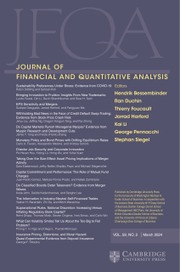Article contents
Is There Smart Money? How Information in the Commodity Futures Market Is Priced into the Cross Section of Stock Returns with Delay
Published online by Cambridge University Press: 31 January 2023
Abstract
We document a new empirical phenomenon in which the aggregate positions of money managers, who are sophisticated speculators in the commodity futures market, as disclosed by the Disaggregated Commitments of Traders reports, can predict the cross section of commodity producers’ stock returns in the subsequent week. We employ a number of cross-sectional methods, including calendar-time regression analysis, single-sort, double-sort, and Fama–MacBeth regressions, to confirm the predictability results. The results are more pronounced in firms with higher information asymmetry. We thus add more empirical evidence to the literature on costly information processing, which leads to gradual information diffusion across asset markets.
Information
- Type
- Research Article
- Information
- Journal of Financial and Quantitative Analysis , Volume 58 , Issue 8 , December 2023 , pp. 3201 - 3230
- Creative Commons
- This is an Open Access article, distributed under the terms of the Creative Commons Attribution-NonCommercial-NoDerivatives licence (https://creativecommons.org/licenses/by-nc-nd/4.0), which permits non-commercial re-use, distribution, and reproduction in any medium, provided that no alterations are made and the original article is properly cited. The written permission of Cambridge University Press must be obtained prior to any commercial use and/or adaptation of the article.
- Copyright
- © The Author(s), 2023. Published by Cambridge University Press on behalf of the Michael G. Foster School of Business, University of Washington
Footnotes
We have greatly benefited from the comments by Hendrik Bessembinder (the editor) and Neil Pearson (the referee). We are indebted to Brian Henderson (discussant) as well as the participants at the AFA 2019 Atlanta Annual Meeting for insights. We are also grateful for Alminas Zaldokas (discussant) and seminar participants at the Paris Winter 2018 Conference. We also thank Gang Li (discussant) and audience at the SFS Cavalcade Asia-Pacific 2019, and seminar participants at Queen’s University, University of Guelph, and University of Nottingham for helpful inputs. We thank Patrick Bolton, Paul Calluzzo, Saeyoung Chang, Daniel Chi, David Feldman, Ana-Maria Fuertes, Louis Gagnon, Lawrence Glosten, Matthieu Gomez, Lars Peter Hansen, Robert Hodrick, Harrison Hong, Melvin Jameson, Wei Jiang, Michael Johannes, Harry Mamaysky, Rahul Mukherjee, Nick Pan, Neil Pearson, Percy Poon, José Scheinkman, Michael Sullivan, Suresh Sundaresan, Cédric Tille, Neng Wang, Wei Wang, Laura Veldkamp, Zihan Ye, and Andrew Zhang for comments and suggestions.
References
- 2
- Cited by

